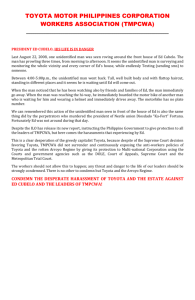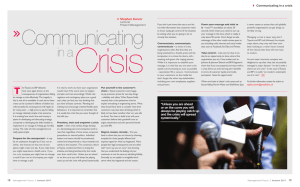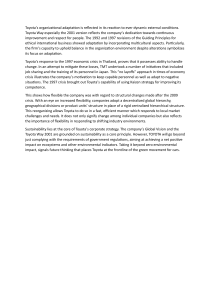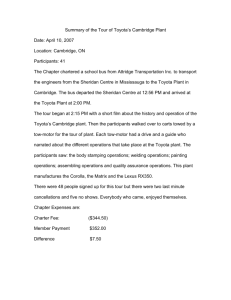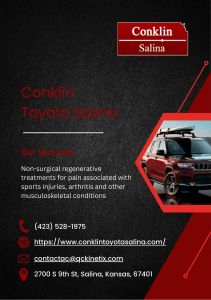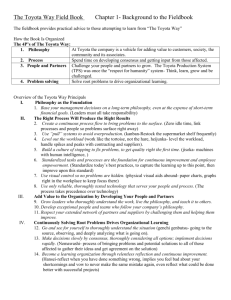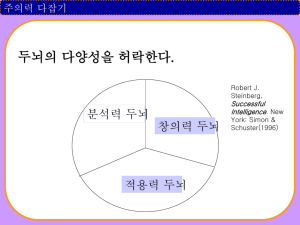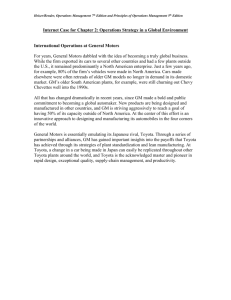Presentation
advertisement
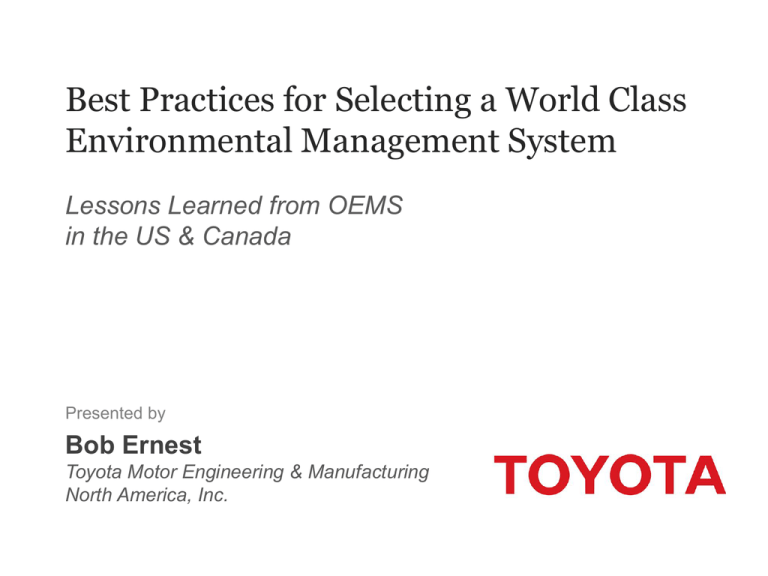
Best Practices for Selecting a World Class Environmental Management System Lessons Learned from OEMS in the US & Canada Presented by Bob Ernest Toyota Motor Engineering & Manufacturing North America, Inc. Environmental Sustainability Manage to Succeed Measure to Manage Standardize to Measure North American Pollutant Registries México Canada Registro de Emisiones y Transferencia de Contaminantes (RETC) National Pollutant Release Inventory (NPRI) United States Toxics Release Inventory (TRI) What do they have in common? They’re all about measuring… “A hundred ordeals, a thousand trials, and finally the matter is accomplished” Lessons Learned... the Hard Way Lead to ... Best Practices Yokoten Yokoten is a fundamental practice at Toyota It means implementing someone else’s practice and reaping the benefits Using a system that incorporates ideas and countermeasures of others is a great example of Yokoten. Yokoten – Learning from others’ experience Systems need to empower people and make them more efficient Common problems found across North America in our industry Some examples…. “We have a small team. It’s really about making sure that the team is efficient... We must keep up with expansion and not have to redevelop our system” Halle Price, Environmental Engineer “Our group is small, and was recently downsized, so we’re kind of scrambling… Reporting was becoming more & more overwhelming… …my accuracy was definitely slipping. Maureen Ramsay, Technical Coordinator, Environmental Group “Before we got a consolidated system, we spent half our time on QA and correcting errors Our IS group had developed an in-house system that worked well but was aging. It needed up-keep which they couldn’t provide because we were increasing production. Jared Lynn, Environmental Engineer “We needed a system that manages the data and calculations for us, so we can spend more time doing meaningful work, not manipulating data and fixing errors every month.” David Steedly, Toyota Motor Manufacturing Kentucky “The objective of our system is time savings, accuracy up, and succession planning. 2 or 3 of us are eligible for retirement within 5 years. Make-shift excel sheets were going to make it very difficult for someone else to come into this role.” Maureen Ramsay, Technical Coordinator, Environmental Group If information is buried in a table in some database and you can’t demonstrate (to auditors) how you calculate your emissions, it doesn’t matter how accurate your results are. David Steedly, Toyota Motor Manufacturing Kentucky Adapting to change Your system must be: Flexible and support change Contain a toolset to adapt to business needs With constant plant changes, work is never over You need a system that can adjust to changes Lessons learned... Common Lessons Bad System Ideas: Systems that can not be maintained Unsupported Env. staff selfmade systems Env Professionals tasked as computer programmers Thinking environmental systems are static not dynamic Choosing developer without environmental expertise Lessons learned... Common Lessons It is Time Consuming to: Develop internal systems Find external computer systems Implement computer systems Organization is vital Multiple databases / spreadsheets are trouble The Team needs diverse skills – knowledge of regulations, processes Time Allocation is vital – don’t spend valuable time on trivial issues Focus on the most important chemicals / processes Use visual tools, material balance, flow diagrams, process diagrams top ten lists As soon as the report is complete have a reflection meeting and identify improvements for next year



